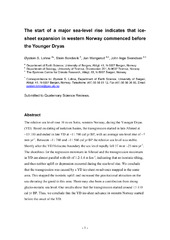Late Weichselian relative sea-level changes and glacial history in Hordaland, Western Norway
Doctoral thesis
Permanent lenke
https://hdl.handle.net/1956/1178Utgivelsesdato
2006-05-19Metadata
Vis full innførselSamlinger
- Department of Earth Science [1103]
Sammendrag
Two well dated lateglacial relative sea-level curves have been constructed from Hordaland, western Norway, by the isolation basin method. The easternmost curve is based on six basins from the Os area, close to the Younger Dryas (YD) ice-sheet margin, at a YD isobase of 58 m a.s.l. The western curve was constructed at a site 20 km further west, at a YD isobase of 40 m, and is based on detailed studies of three basins located on the island of Sotra. In addition 22 basins from an earlier conducted study on Sotra have been re-evaluated and calibrated, and the presented curve consists of 43 sea-level index points documenting the complete late- and postglacial sea-level history of Sotra. A major feature in the lateglacial sea-level history of western Norway is the YD transgression, representing a rise in relative sea level of 10 m. It temporarily reversed the ongoing relative sea-level fall following the deglaciation. The transgression started in late Allerød, 200-300 years before the YD cooling, and culminated in the late YD. The highstand at the YD transgression maximum had duration of about 200 years, and the sea level fell rapidly slightly after the YD/Holocene boundary and the rise in the birch (Betula) pollen curve. The two sea-level curves and marine limit terraces in the area have been used to construct a shoreline diagram with shorelines for the regression minimum in Allerød and the YD transgression maximum. These shorelines have almost parallel tilts of 1.2-1.4 m km-1, indicating that no isostatic tilting, and thus neither uplift nor depression occurred during the sea-level rise. It is concluded that the YD transgression was caused by a major YD ice-sheet advance mapped in the same area. This stopped the isostatic uplift and increased the gravitational attraction on the sea which elevated the geoid in this area. There may also have been a contribution from rising glacio eustatic sea level. The YD transgression started in the late Allerød, thus it is concluded that the YD ice-sheet advance started before the onset of the YD. Recently, several scientists have postulated that there was no major glacier advance during the YD, based on observations along the Hardangerfjord. If correct, this has consequences for the proposed explanation of the YD transgression, and it is therefore performed a test by dating the large terminal moraine crossing the fjord close to the fjord mouth. The results indicate that the terminal moraine at the mouth of Hardangerfjorden was deposited in mid and late YD (10.6-10.0 kyr 14C BP). It is concluded that the there was a major YD ice-sheet advance in western Norway, also in the Hardangerfjord area.
Består av
Paper I: Rerpinted from Calendar year age estimates of Allerød - Younger Dryas sea-level oscillations at Os, western Norway. Journal of Quaternary Science 19, 443-464. Lohne, Ø.S., Bondevik, S., Mangerud, J. and Schrader, H., Copyright 2004. Copyright John Wiley & Sons Limited. Reproduced with permission.Paper II: Lohne, Ø.S., Bondevik, S., Mangerud, J. and Svendsen, J.I., submitted. The start of a major sea-level rise indicates that ice-sheet expansion in western Norway commenced before the Younger Dryas. Submitted to Quaternary Science Reviews, Copyright 2006 Elsevier.
